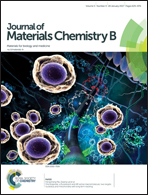Bio-engineered electrospun nanofibrous membranes using cartilage extracellular matrix particles
Abstract
Biological and biomimetic decellularized scaffolds can mimic a natural tissue environment to derive cell proliferation and differentiation without eliciting adverse immune responses during tissue regeneration. Polymeric nanofibrous membranes also served as appropriate matrices for cellular behavior because of their resemblance to physical dimensions of natural extracellular matrix (ECM), while they often have insufficient biological cues to address the cellular phenotype. In this study, we designed bio-engineered membranes through covalent immobilization of decellularized ECM (DECM) particles on the surface of electrospun nanofibers and examined the ability of these composite materials for chondrogenesis. After successful chemical decellularization of human nasal septum cartilage constructs (hNSCs), mechanical processing was carried out and particles with a diameter mean size of 5.06 ± 2.70 μm were yielded. Poly hydroxyalkanoate (PHA) nanofibrous scaffolds were functionalized with DECM particles to mimic the natural motifs of cartilage ECM. Human adipose derived stem cells (hASCs) and human primary chondrocytes (hPChs) cultured on these biofunctional scaffolds showed a significant increase in collagen formation and chondrogenic marker expression after 21 days of cell culture. These results are exciting as they indicate the feasibility of creating bio-engineered scaffolds that may be non-immunogenic as a replacement tissue and have great potential for meeting new challenges in regenerative medicine, particularly in relation to cartilage reconstruction.



 Please wait while we load your content...
Please wait while we load your content...